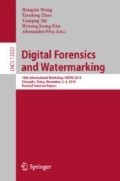Abstract
In conventional image steganalysis, cover-source mismatch is a serious problem restricting its utility. In our work, we validate that in deep steganalysis, cover-source mismatch still exists. But unlike in conventional scenarios, sharp accuracy reduction just exists in a part of cover-source mismatch scenarios in deep steganalysis. To explain this phenomenon, we use A-distance to measure the texture complexity between databases. Furthermore, to ease the accuracy reduction caused by the mismatch, we adapt JMMD into deep steganalysis and design a new network (J-Net). Extensive experiments prove A-distance and J-Net works well.
Access this chapter
Tax calculation will be finalised at checkout
Purchases are for personal use only
References
Ben-David, S., Blitzer, J., Crammer, K., Kulesza, A., Pereira, F., Vaughan, J.W.: A theory of learning from different domains. Mach. Learn. 79(1), 151–175 (2009). https://doi.org/10.1007/s10994-009-5152-4
Bengio, Y., Courville, A., Vincent, P.: Representation learning: a review and new perspectives. IEEE Trans. Pattern Anal. Mach. intell. 35(8), 1798–1828 (2013)
Boroumand, M., Chen, M., Fridrich, J.: Deep residual network for steganalysis of digital images. IEEE Trans. Inf. Forensics Secur. 14(5), 1181–1193 (2018)
Chaumont, M.: Deep learning in steganography and steganalysis from 2015 to 2018. arXiv preprint arXiv:1904.01444 (2019)
Chen, M., Xu, Z., Weinberger, K., Sha, F.: Marginalized denoising autoencoders for domain adaptation. arXiv preprint arXiv:1206.4683 (2012)
Deng, C., Xue, Y., Liu, X., Li, C., Tao, D.: Active transfer learning network: a unified deep joint spectral-spatial feature learning model for hyperspectral image classification. IEEE Trans. Geosci. Remote Sens. 57(3), 1741–1754 (2018)
Glorot, X., Bordes, A., Bengio, Y.: Domain adaptation for large-scale sentiment classification: a deep learning approach. In: Proceedings of the 28th International Conference on Machine Learning (ICML-11), pp. 513–520 (2011)
Holub, V., Fridrich, J.: Designing steganographic distortion using directional filters. In: 2012 IEEE International Workshop on Information Forensics and Security (WIFS), pp. 234–239. IEEE (2012)
Holub, V., Fridrich, J., Denemark, T.: Universal distortion function for steganography in an arbitrary domain. EURASIP J. Inf. Secur. 2014(1), 1–13 (2014). https://doi.org/10.1186/1687-417X-2014-1
Kodovskỳ, J., Sedighi, V., Fridrich, J.: Study of cover source mismatch in steganalysis and ways to mitigate its impact. In: Media Watermarking, Security, and Forensics 2014, vol. 9028, p. 90280J. International Society for Optics and Photonics (2014)
Long, M., Cao, Y., Wang, J., Jordan, M.I.: Learning transferable features with deep adaptation networks. arXiv preprint arXiv:1502.02791 (2015)
Long, M., Zhu, H., Wang, J., Jordan, M,I.: Deep transfer learning with joint adaptation networks. In: Proceedings of the 34th International Conference on Machine Learning, vol. 70, pp. 2208–2217. JMLR. org (2017)
Lubenko, I., Ker, A.D.: Steganalysis with mismatched covers: Do simple classifiers help? In: Proceedings of the on Multimedia and Security, pp. 11–18. ACM (2012)
Madasu, A., Rao, V.A.: Gated convolutional neural networks for domain adaptation. In: Métais, E., Meziane, F., Vadera, S., Sugumaran, V., Saraee, M. (eds.) NLDB 2019. LNCS, vol. 11608, pp. 118–130. Springer, Cham (2019). https://doi.org/10.1007/978-3-030-23281-8_10
Pasquet, J., Bringay, S., Chaumont, M.: Steganalysis with cover-source mismatch and a small learning database. In: 2014 22nd European Signal Processing Conference (EUSIPCO), pp. 2425–2429. IEEE (2014)
Pibre, L., Pasquet, J., Ienco, D., Chaumont, M.: Deep learning is a good steganalysis tool when embedding key is reused for different images, even if there is a cover sourcemismatch. Electron. Imaging 2016(8), 1–11 (2016)
Purushotham, S., Carvalho, W., Nilanon, T., Liu, Y.: Variational recurrent adversarial deep domain adaptation (2016)
Qian, Y., Dong, J., Wang, W., Tan, T.: Deep learning for steganalysis via convolutional neural networks. In: Media Watermarking, Security, and Forensics 2015, vol. 9409, pp. 94090J. International Society for Optics and Photonics (2015)
Sejdinovic, D., Sriperumbudur, B., Gretton, A., Fukumizu, K., et al.: Equivalence of distance-based and rkhs-based statistics in hypothesis testing. Ann. Stat. 41(5), 2263–2291 (2013)
Tzeng, E., Hoffman, J., Zhang, N., Saenko, K., Darrell, T.: Deep domain confusion: Maximizing for domain invariance. arXiv preprint arXiv:1412.3474 (2014)
Guanshuo, X., Han-Zhou, W., Shi, Y.-Q.: Structural design of convolutional neural networks for steganalysis. IEEE Signal Process. Lett. 23(5), 708–712 (2016)
Ye, J., Ni, J., Yi, Y.: Deep learning hierarchical representations for image steganalysis. IEEE Trans. Inf. Forensics Secur. 12(11), 2545–2557 (2017)
Yedroudj, M., Comby, F., Chaumont, M.: Yedroudj-net: an efficient cnn for spatial steganalysis. In: 2018 IEEE International Conference on Acoustics, Speech and Signal Processing (ICASSP), pp. 2092–2096. IEEE (2018)
Yosinski, J., Clune, J., Bengio, Y., Lipson, H.: How transferable are features in deep neural networks? In: Advances in Neural Information Processing Systems, pp. 3320–3328 (2014)
Zhang, R., Zhu, F., Liu, J., Liu, G.: Depth-wise separable convolutions and multi-level pooling for an efficient spatial CNN-based steganalysis. IEEE Trans. Inf. Forensics Secur. 15, 1138–1150 (2019)
Author information
Authors and Affiliations
Corresponding author
Editor information
Editors and Affiliations
Rights and permissions
Copyright information
© 2020 Springer Nature Switzerland AG
About this paper
Cite this paper
Zhang, X., Kong, X., Wang, P., Wang, B. (2020). Cover-Source Mismatch in Deep Spatial Steganalysis. In: Wang, H., Zhao, X., Shi, Y., Kim, H., Piva, A. (eds) Digital Forensics and Watermarking. IWDW 2019. Lecture Notes in Computer Science(), vol 12022. Springer, Cham. https://doi.org/10.1007/978-3-030-43575-2_6
Download citation
DOI: https://doi.org/10.1007/978-3-030-43575-2_6
Published:
Publisher Name: Springer, Cham
Print ISBN: 978-3-030-43574-5
Online ISBN: 978-3-030-43575-2
eBook Packages: Computer ScienceComputer Science (R0)

